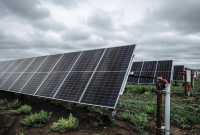Support strong Canadian climate journalism for 2025
Diversification of Alberta’s energy industry is leading to a new and significant input to municipal tax revenues from wind and solar projects.
Since the revenues were first estimated in 2017, payments to southern Alberta municipalities have tripled to $28 million, according to our new analysis. This cash gives communities the freedom to lower taxes, tackle critical projects or provide additional services.
Eight of the 18 municipalities that are home to wind and solar projects received $1 million or more. In some cases, this money makes up a significant percentage of their total operating revenues.
It adds up to 50 per cent in the County of Forty Mile. For the Municipal District of Pincher Creek, it’s 31 per cent, while the Municipal District of Willow Creek follows closely with 29 per cent.
These are not insignificant amounts for jurisdictions with a small tax base, some with dwindling oil and gas activity. Wind and solar projects won’t run out of energy, so these are long-term, reliable revenue streams that will allow municipalities to plan for the future.
The forecasts for these funds show additional prosperity just over the horizon. Based on the projects that were lined up before the Alberta government’s moratorium announcement, an additional $170 million to $250 million in revenues could bolster municipal budgets in just a few years.
Given these numbers, it’s unsurprising that a recent Pembina Institute poll showed 75 per cent of Albertans — including 66 per cent living outside of Edmonton and Calgary — would like to see more renewable energy projects in their communities.
In addition, 70 per cent thought the Alberta government should be doing more to encourage future development of emissions-free energy, such as wind and solar power, in the province.
Instead, the province brought project applications to a halt this summer when it announced a seven-month moratorium on the approval of new renewable projects over one megawatt. This “pause,” as they prefer to call it, is short-sighted and hurts municipalities.
At a minimum, it pushes back any projects that weren’t already approved until at least March 2024. This also delays when municipalities will receive revenue from those projects because tax revenues don’t kick in until a project is operating.
Aside from delayed tax revenue, the moratorium also blocks the additional benefits brought by renewable energy projects. Of course, there is the clean, emissions-free energy that needs to be brought online as quickly as possible to replace our current carbon-emitting sources.
But wind and solar projects have also brought $5.5 billion worth of corporate investment to Alberta, along with thousands of jobs and enough energy to power the equivalent of 1.5 million homes.
Alberta has the country’s fastest-growing population, which means — barring concerted energy efficiency efforts — energy demand is likely to increase. Coupled with widespread corporate sustainability goals, it’s clear there will continue to be a strong practical need and desire to develop more wind and solar projects in Alberta.
It was obvious from the start of the renewable energy inquiry that developers and buyers would wait with bated breath to see how the outcome would affect the market. But now we can see that many Alberta municipalities have reason to be deeply concerned, as well.
Ideally, the government would lift the moratorium while conducting its inquiry, which will inform the government’s renewable energy policies related to agricultural land use, reclamation requirements, impacts on “pristine viewscapes” and development on Crown land.
But barring that, we hope the recommendations to be delivered by the Alberta Utilities Commission by March 29, 2024, are fair and not punitive and that they are rapidly reviewed and adopted by the provincial government. They should also minimize disruptions to industry and refrain from increasing costs at a time of global competition and inflation.
For, as we’ve now calculated and reported, a robust renewable energy sector has many beneficiaries, and municipalities are among them.
Jorden Dye is a strategic manager focused on accelerating the energy transition. Before joining BRC-Canada, Jorden worked at Mount Royal University's Institute for Environmental Sustainability. His work focused on industrial environmental disclosure, industry response to the energy transition and scaling a Parks Canada initiative.






Comments
Unfortunately, the province of Alberta does not have a rational premier in charge.
The moratorium was enacted pretty well concurrently with the gas-burning private utilities quadrupling their prices. One could ask questions if coordination and collusion were practiced here.
Alberta towns, farmers and First Nations that benefit from solar and wind projects need to organize and lobby the Utilities Commission and government to do research into the consequences and lost opportunities of continuing the moratorium or placing unjustified hurdles and roadblocks against new solar and wind projects. In fact, they should hire professional, reputable energy consultants themelves to produce a solid, well referenced report on this issue that will stand up to scrutiny.
One consequence could be farmers, First Nations, urban home and business owners and possibly entire towns going off grid with their own renewable infrastructure due to the high artificial costs imposed by private utilities connected to the grid. Alberta may regulate electricity generation and the grid, but surely that regulation won't prevent private individuals placing solar panels on their roofs for their own use and cutting their grid connection as long as they follow the Building Code.
Expand that concept a little and you've got small private non-profit independent grids owned by ratepayers within towns.
Danielle Smith is belligerent enough to try to stop Albertans from putting rooftop solar arrays on their own roofs, but she'll have to have the Solar Police force enter private property to rip down panels.
That idea is ludicrous, but then so are the consequences of making the moratorium or facsimile permanent on legitimate projects, especially when timed with UCP-friendly private gas-fired utilities jacking prices across the board by 4X.